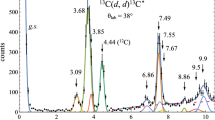Abstract.
The 111Tc nucleus, populated in the spontaneous fission of 248Cm, was studied by means of prompt γ-ray spectroscopy using the EUROGAM2 array. Excited states in 111Tc were observed for the first time. Systematics of energy levels in odd-A Tc isotopes, obtained in our study of 107Tc and 109Tc provide a reliable spin and parity assignment I = 5/2+ to the head of the new band in 111Tc, interpreted as the π5/2+[422] orbital originating from the proton g9/2 shell. This level is most likely the ground state. Therefore, the (9/2+,7/2+) spin-parity assignment to the ground state of 111Tc, reported previously, is unlikely. Properties of the yrast band in 111Tc suggest prolate deformation of this band. There are hints that the deformation of 111Tc is larger than that of 109Tc, possibly due to admixtures of oblate-deformed configurations, which lower their excitation energy with increasing neutron number.
Similar content being viewed by others
References
W. Urban, Eur. Phys. J. A 20, 381 (2004).
M.C.A. Hotchkis, Nucl. Phys. A 530, 111 (1991).
M. Houry, Eur. Phys. J. A 6, 43 (1999).
X.Q. Zhang, Phys. Rev. C 61, 014305 (1999).
P. Moller, At. Data Nucl. Data Tables 59, 185 (1995).
F.R. Xu , Phys. Rev. C 65, 021303(R) (2002).
F.-K. Thieleman, K.-L. Kratz, Proceedings of the XXII Masurian Lakes Summer School, Poland, 1991 (IOP Publishing) pp. 187-226.
G. Audi, A.H.Wapstra, C. Thibault, Nucl. Phys. A 729, 337 (2003).
H. Ohm, JUL-Spez-304 (1986) p. 30.
J.W. Borgs, Nucl. Instrum. Methods B 26, 304 (1987).
J.K. Hwang, Phys. Rev. C 57, 2250 (1998).
Evaluated Nuclear Structure Data File (2004), www.nndc. bnl.gov.
W. Urban, Phys. Rev. C 70, 057308 (2004).
W. Urban, in preparation.
W. Urban, Z. Phys A 358, 145 (1997).
W. Urban, Eur. Phys. J. A 5, 239 (1999).
P. Bhattacharyya, Phys. Rev. C 56, R2363 (1997).
C.T. Zhang, Phys. Rev. Lett. 77, 3743 (1996).
A. Bauchet , Eur. Phys. J. A 10, 145 (2001).
Ts. Venkova, Eur. Phys. J. A 15, 429 (2002).
Y.X. Luo, Phys. Rev. C 70, 04310 (2004).
Author information
Authors and Affiliations
Corresponding author
Additional information
D. Schwalm
Rights and permissions
About this article
Cite this article
Urban, W., Rzaca-Urban, T., Durell, J.L. et al. First observation of excited states in the 111Tc nucleus --A new region of deformation at 40 ⩽ Z ⩽ 46, N ≥ 68?. Eur. Phys. J. A 24, 161–165 (2005). https://doi.org/10.1140/epja/i2004-10140-7
Received:
Accepted:
Published:
Issue Date:
DOI: https://doi.org/10.1140/epja/i2004-10140-7




